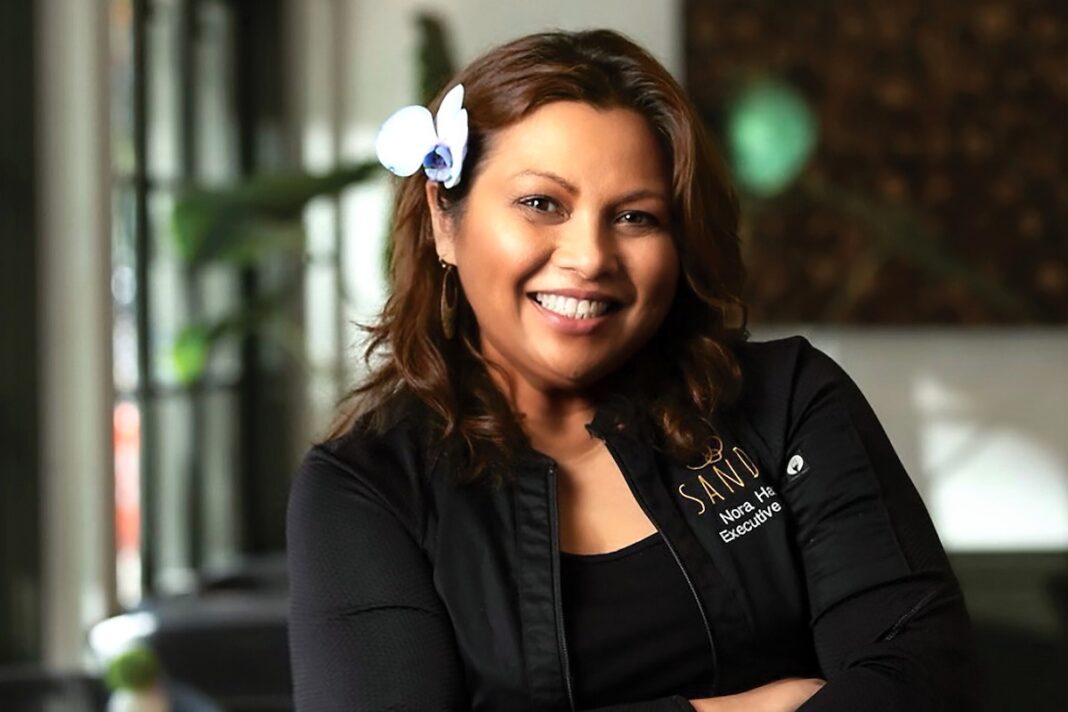Late 2000s Clement Street housed Singapore Malaysian Restaurant. If the dry heat led to caving in the East Bay, the mie tek tek at Padi in San Leandro provided comfort. And having overcome heat, terrible parking and an awful drive from anywhere else in the Bay Area, making a stop at Jayakarta in Berkeley was a reward—not accounting for the long lines customers would’ve had to wade through.
All these locations closed either during or previous to the pandemic. This part of Southeast Asian cuisine is marked more for its precarity than its longevity in the Bay Area. Chef Nora Haron has a theory why.
Haron, director of culinary for Killiney Kopitiam USA and SanDai Restaurant + KopiBar, claims a number of these restaurants served the 2% of the Southeast Asians from the Malay Archipelago, as opposed to the 98% of the Americans, who comprise the majority of her customers. It’s a continuous battle to balance those two interests.
An early example she points to in her career is the initial frustration she felt when serving Hainanese chicken. She says, “With Drip Line, I remember when I first did the chicken rice, the Hainanese chicken rice, and you know you serve room temperature cold chicken? And the Americans look at that like, are you serious? You’re serving me this? So at Drip Line, I had to fry that chicken to make it palatable for the Americans.” It’s not a revision she objected to, however, as her calling card is bridging elements of other cuisines with Nusantaran dishes.
Some of these dishes include: otak otak with trout, ribeye satay, laksa albondigas, bubur ayam with Mexican rice and horchata with Indonesian black rice pudding. And some of these recipes came from previous connections. She often mentions that the sambal grits were inspired by her relationship with her ex-husband. It’s been written that her Indonesian concha is a mixture of her and her partner’s cultures. In finding these connections and servicing the customer base she’s acquired, Haron opposes the requests she receives for authentic Nusantaran cuisine. In response, she often asks, for whom is it authentic?
There’s a history regarding this call for cuisine authenticity. Most food historians note the inception of fusion food with Wolfgang Puck’s Chinois in Santa Monica, fusing elements of Chinese food with French cuisine. Many saw fusion as a way to make a name for themselves, whether or not the fusion dish was itself an original invention. After a while, according to the writer Jaya Saxena, the world oscillated back to a call for authenticity by the early 2000s.
Saxena writes, aided by apps like Foursquare and Yelp, anyone could be considered a food authority, and calls for an “authentic experience” were an aesthetic overture. Using the example of Mexican food, she states, “It is based on a preconceived notion of what ‘real’ Mexican food is, regardless of what relationship the diner has to Mexican cuisine in the first place.”
It’s an aesthetic overture as much as it was a call for overcorrection for food media’s past faults. But in its efforts for overcorrection, Saxena argues it resulted in people wanting to admonish white chefs for getting famous cooking “ethnic” food and constraining non-white chefs to abide by said preconceived notions of authenticity. At this moment in time, calls for authenticity have been reduced to conservative and millennial outrage fodder, and the pendulum has effectively swung back.
The call for authenticity is also difficult to accomplish, as many chefs have pointed out, where do their histories fit in? Haron echoes this sentiment, saying, “There is this whole struggle with ‘your food is not authentic.’ Says who?” For a number of chefs, their cuisine cannot be delineated from one country to the next.
The Nusantara region of Southeast Asia is known for bridging different countries’ influences into the cuisine, and this is not including the influence of the many different colonial overlords. For Haron, blending cultures is part and parcel of having grown up in Singapore. From the Nusantara region alone, there are more than two dozen different laksas—spicy noodle soups—particular to a specific country or city, and it was important for Haron to introduce a Nusantara-Californian laksa in the Bay Area.
As far as Haron’s life story goes, her great-grandmother, grandmother and great-aunt came to Singapore on a boat from the Islands of Java to meet her great-uncle, who was waiting for them. Years later, her grandmother met her Kerala-based Tamilian father there, who was working as a chemist for the British in the former British crown colony of Singapore.
Fast forward many years and to a new country, with Haron living in the Bay Area. Along the way, she’s taken a circuitous path to becoming a chef. She initially worked in fashion. When she was working in Italy, she rediscovered her love for food and returned to working in that industry. Her mother, a cook herself, wanted her to do anything but. And in many ways, certain conversations repeat themselves. So eventually she was sure to have the “Do you really want to do this?” conversation with her own kids.
Haron’s oldest son, Mohammad Haadee, is a barista, while her second son, Ali Haadee, makes the croissants for the Kopi bar. Her youngest, Nile Dunning, works at SanDai during the summer. She stresses how her daughter, Ameera, tried everything before working as her sous chef. Ameera Haadee helped her mother with the opening of both Killiney Kopitiam in Palo Alto and SanDai in Walnut Creek, the latter of which is living up to its name. SanDai, 三代, meaning “three generations” in Mandarin, continues a legacy that includes her mother’s inspiration, Haron’s recipes and her family working in the restaurant.
Legacy, while prescribed in the name of the restaurant, is not as relevant as Haron’s desire to make Nusantaran cuisine in the Bay Area, and she is aware of the spotlight on her. She never stops moving, with a number of new projects, which include television. This past August, SanDai celebrated its own SanDai festival to celebrate the independence days of this region, and Haron, alongside Amanda Steckler, is moving forward with opening new locations, even though plans are slowed due to current market conditions.
The next location in the works, modeled off of Killiney, is opening in Valley Fair in 2024. In the meantime, if one is visiting SanDai, it’s suggested to pair the cuisine with a riesling, try the urab salad or get the laksa with a summer sling.












Without a doubt, one of the best restaurant reviews I’ve ever read. Harkens back to the NYT’s Bryan Miller of the 1990s. The review has no ego getting in the way, it’s well-researched, educational, respectful and beautifully written. I’m not sure I’ve seen a piece of food-oriented journalism as good as this ever in any California publication.